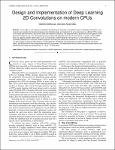Design and Implementation of Deep Learning 2D Convolutions on modern CPUs
| dc.contributor.author | Kelefouras, V | |
| dc.contributor.author | Keramidas, G | |
| dc.date.accessioned | 2023-10-03T10:45:29Z | |
| dc.date.available | 2023-10-03T10:45:29Z | |
| dc.date.issued | 2023-10-04 | |
| dc.identifier.issn | 1558-2183 | |
| dc.identifier.issn | 1558-2183 | |
| dc.identifier.uri | https://pearl.plymouth.ac.uk/handle/10026.1/21352 | |
| dc.description.abstract |
In this article, a new method is provided for accelerating the execution of convolution layers in Deep Neural Networks. This research work provides the theoretical background to efficiently design and implement the convolution layers on x86/x64 CPUs, based on the target layer parameters, quantization level and hardware architecture. The proposed work is general and can be applied to other processor families too, e.g., Arm. The proposed work achieves high speedup values over the state of the art, which is Intel oneDNN library, by applying compiler optimizations, such as vectorization, register blocking and loop tiling, in a more efficient way. This is achieved by developing an analytical modelling approach for finding the optimization parameters. A thorough experimental evaluation has been applied on two Intel CPU platforms, for DenseNet-121, ResNet-50 and SqueezeNet (including 112 different convolution layers), and for both FP32 and int8 input/output tensors (quantization). The experimental results show that the convolution layers of the aforementioned models are executed from x1.1 up to x7.2 times faster. | |
| dc.format.extent | 3104-3116 | |
| dc.publisher | Institute of Electrical and Electronics Engineers | |
| dc.subject | Deep neural networks | |
| dc.subject | convolution | |
| dc.subject | oneDNN | |
| dc.subject | optimization | |
| dc.subject | analytical model | |
| dc.subject | vectorization | |
| dc.subject | register blocking | |
| dc.subject | loop tiling | |
| dc.title | Design and Implementation of Deep Learning 2D Convolutions on modern CPUs | |
| dc.type | journal-article | |
| dc.type | Article | |
| plymouth.issue | 12 | |
| plymouth.volume | 34 | |
| plymouth.publication-status | Published | |
| plymouth.journal | IEEE Transactions on Parallel and Distributed Systems | |
| dc.identifier.doi | 10.1109/tpds.2023.3322037 | |
| plymouth.organisational-group | |Plymouth | |
| plymouth.organisational-group | |Plymouth|Faculty of Science and Engineering | |
| plymouth.organisational-group | |Plymouth|Faculty of Science and Engineering|School of Engineering, Computing and Mathematics | |
| plymouth.organisational-group | |Plymouth|REF 2021 Researchers by UoA | |
| plymouth.organisational-group | |Plymouth|Users by role | |
| plymouth.organisational-group | |Plymouth|Users by role|Academics | |
| plymouth.organisational-group | |Plymouth|REF 2021 Researchers by UoA|UoA11 Computer Science and Informatics | |
| dcterms.dateAccepted | 2023-09-29 | |
| dc.date.updated | 2023-10-03T10:45:29Z | |
| dc.rights.embargodate | 2023-10-25 | |
| dc.identifier.eissn | 1558-2183 | |
| dc.rights.embargoperiod | ||
| rioxxterms.versionofrecord | 10.1109/tpds.2023.3322037 |


